-
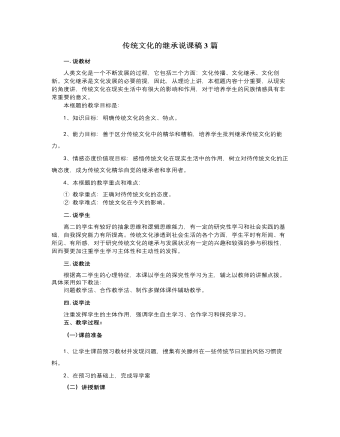
人教版高中政治必修3传统文化的继承说课稿3篇
(二)课堂教学在教学中,无论是形式还是内容,都必须统一于学生的发展。从形式上说,以学生展示、思考、讨论为主,教师点拨为辅,在一定的情境与社会文化背景下,获得对传统文化的认识和理解。从内容上说,主要以福州地方传统文化为素材,围绕海峡两岸同时举办的“元霄灯会”为主线,回归到学生的生活世界,更有效地激发起学生情感,并将生活世界与知识世界衔接起来,在实际情景中分析传授相关传统文化的知识,提高学生认识和分析解决问题的能力,逐步形成对传统文化的情感和价值判断。教学过程,紧紧围绕传统文化,分为“激趣导入--活动感悟--探究思辩--升华导行”四个层次,环环相扣,逐步推进,帮助学生完成由感性认识到理性认识的飞跃。1.激趣导入良好的开端是成功的一半。德国的普克朗认为:“思考可以构成一座桥,让我们通向新知识”。因此,一开始,我就运用对比方法,进行设问,福州和西安、南京、北京一样也是历史文化名城,你们同意吗?
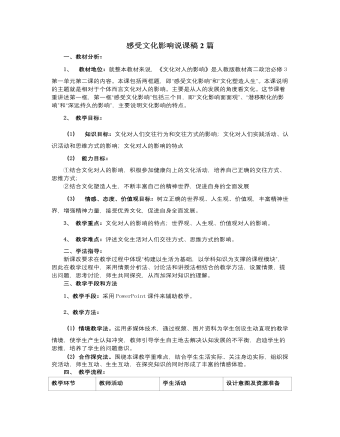
人教版高中政治必修3感受文化影响说课稿2篇
3、问题设计:文化除了影响人们的交往行为和交往方式外,还影响人们的什么?4、师生总结得出结论:文化影响人们的实践活动、认识活动和思维方式。设计意图:通过主题的指引,让学生查阅并说说中国传统节日的来源、传说和意义。这是基于丰富课程资源的设计,将生活和学习领域的多种资源纳入课程的范畴,在活动中自主建构知识,并在教师的引导下,提高分析和解决问题能力,培养热爱祖国的思想感情,突破本框题第二个重点。过渡设问:文化对人影响有什么特点?设计意图:通过问题提示,集中学生的注意力,导入下一个环节的教学。环节三:文化对人潜移默化的影响。教案:1、多媒体播放“孟母三迁”故事动画片。2、讨论问题:“孟母三迁”的故事给我们什么启示?3、师生总结得出结论:文化对人具有潜移默化的影响。设计意图:“孟母三迁”的故事学生比较熟悉,而且这个故事的思想教育性较强。
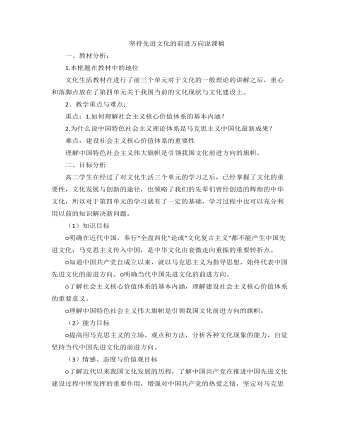
人教版高中政治必修3坚持先进文化的前进方向说课稿
教师点拨:是社会主义意识形态的本质体现,是全国人民团结奋斗的共同思想基础。④建设社会主义核心价值体系的要求设置探究问题:建设社会主义核心价值体系的要求有哪些?学生自主学习教材,得出结论板书:3建设社会主义核心价值体系的要求设计意图:在掌握了内容的基础上,这一部分知识的学习水到渠成。高举旗帜科学发展板书:1、中共引领文化前进方向的旗帜是——中国特色社会主义设置探究问题:高举中国特色社会主义伟大旗帜最根本的要求是什么?学生自主学习,回答问题板书:2高举中国特色社会主义伟大旗帜,最根本的是坚持中国特色社会主义理论体系。教师继续追问:这一理论体系的基本内涵是什么?能否举例说明这一理论体系有什么特点。学生讨论,教师点拨:这个理论体系,坚持和发展了马克思列宁主义、毛泽东思想,是马克思主义中国化最新成果。中国特色社会主义理论体系具有强大的生命力、创造力、感召力,是不断丰富和发展的马克思主义
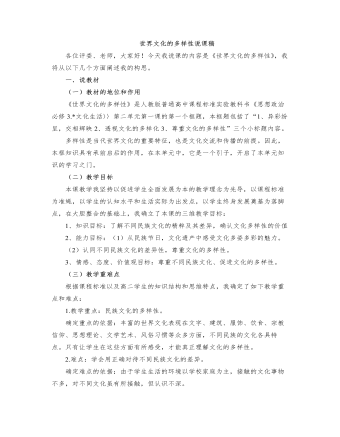
人教版高中政治必修3世界文化的多样性说课稿
设计意图:使同学从各届奥运会会徽的设计上看各国文化,让学生体会不同会徽体现的不同的民族文化,了解不同民族的文化特色,感悟文化多样性的价值,使学生产生情感认同,从而突破难点。探究活动5:教师多媒体呈现中法文化年的flash,显示中国到法国举办中国文化年的图片,比如:在法国街头出现了中国的京剧脸谱,中国孩子玩的风车,中国的大熊猫。出示法国到中国举办文化年的图片,比如:法国在北京举办的音乐会,法国空军的飞行表演等。学生讨论:中法文化年的举办对中法两国来说有什么现实意义?探究活动6:播放理查德.克莱德曼演奏的《梁山伯与祝英台》的视频讨论:(1)此曲吸引你之处在哪里?(2)由此可见,对待文化差异的正确态度是什么?活动5和活动6的设计意图在于让学生懂得,面对开放的世界,既要尊重本民族的文化,同时也要尊重其他民族的文化,从而突破难点。
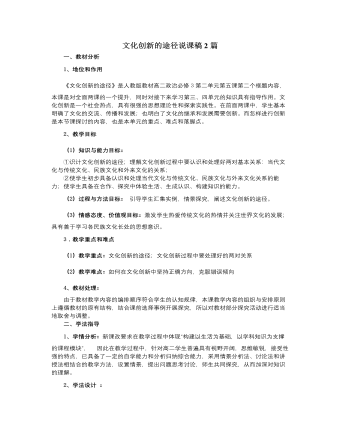
人教版高中政治必修3文化创新的途径说课稿2篇
PPT:文化创新的途径环节二:(展示情境 探究问题)情境一:先后展示徐悲鸿的《奔马图》和《愚公移山》设计意图:在作品的选择上遵循由易到难,由感性到理性的原则让同学们从中体会作者的创作情怀,比较两幅图表达的心境不同之处及其原因。探究一:从创作背景的不同,探究文化创新的根本途径。PPT:(设问)1、为什么同一画家在不同时期,作品所反映的内容不同?2、从中我们可看出,文化创新的根本途径是什么?设计意图:引导学生分析时代的变化对人们的社会实践的影响,因而文化工作者在体验生活的过程中创作的作品意境也会不同,培养学生透过现象看本质的能力,得出文化创新的根本途径是社会实践。教师过渡:在社会实践中,徐悲鸿先生还有什么创作的成功秘诀吗?探究二:从创作心得的展示,探究文化创新的重要途径(PPT)徐悲鸿一生致力于国画的创新实践,他认为革新中国绘画的要旨在于:“古法之佳者,守之;不佳者,改之;垂绝者,继之;未足者,增之;西方画之可采入者,融之。” 设计意图:通过阅读材料,培养学生寻找关键词的能力,并从中总结归纳文化创新的重要途径----继承传统、推陈出新。
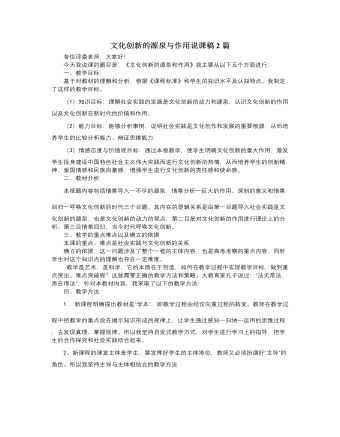
人教版高中政治必修3文化创新的源泉与作用说课稿2篇
一、教学目标:基于对教材的理解和分析,根据《课程标准》和学生的知识水平及认知特点。我制定了这样的教学目标。(1)知识目标:理解社会实践的发展是文化创新的动力和源泉,认识文化创新的作用以及文化创新在新时代的价值和作用。(2)能力目标:能够分析事例,说明社会实践是文化创作和发展的重要根源,从而培养学生的比较分析能力、辩证思维能力(3)情感态度与价值观目标:通过本框教学,使学生明确文化创新的重大作用,激发学生投身建设中国特色社会主义伟大实践而进行文化创新的热情,从而培养学生的创新精神、爱国情感和民族自豪感,增强学生进行文化创新的责任感和使命感。二、教材分析本框题内容包括情景导入--不尽的源泉,情景分析--巨大的作用、深刻的意义和情景回归--呼唤文化创新的时代三个目题。其内在的逻辑关系是由第一目题导入社会实践是文化创新的源泉,也是文化创新的动力的观点,第二目是对文化创新的作用进行理论上的分析。第三目情景回归,当今时代呼唤文化创新。
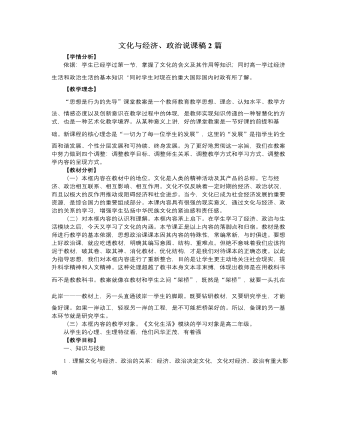
人教版高中政治必修3文化与经济、政治说课稿2篇
2、文化反作用经济政治师:经济政治决定文化,那么,文化不是被动消极的呢?生:思考回答:文化反作用经济政治,不同的文化对经济政治的影响不同。师:文化反作用经济政治,对社会发展有重要影响。文化反作用表现在,文化可以为经济政治的发展,对社会的发展,提供方向保证、智力支持和精神动力。(1)文化反作用的体现。师:现代民主国家中,世界民主的先驱是英国,但英国却有国王,亚洲民主的先驱是日本,但日本却有天皇,其一个重要原因是文化的影响。这说明什么?生:思考发言……师:不同民族的文化,影响不同民族和国家的历史和发展道路。师:中东地区一直以来都是世界热点地区,如巴以冲突、伊拉克战争、阿富汗战争、基地组织等,其一个重要原因是宗教文化的冲突。这说明什么?生:思考发言……师:不同文化的冲突,影响社会的和谐安定和世界的和平安宁。
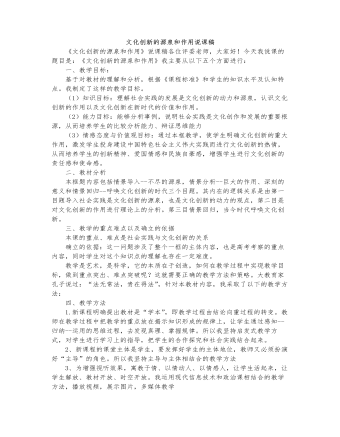
人教版高中政治必修3文化创新的源泉和作用说课稿
二、巨大的作用,深刻地意义材料展示:鲁迅在《狂人日记》中猛烈抨击“吃人”的封建礼教,力图通过自己的呐喊唤醒民众。高尔基早期的作品多描绘俄国沙皇制度下人民的痛苦和他们对美好生活的憧憬。20世纪初,俄国革命形势的发展使他讲文学的笔锋转向革命,创作了《母亲》等作品。合作探究:鲁迅和高尔基的作品在当时的中国和俄国分别起到了什么作用?列举喜爱的一些文学和艺术作品,说说创作者的意图是什么?引导学生自主阅读,培养自主学习能力,掌握分析归纳法和团结协作精神。学生回答之后师生共同总结:文化创新来源于社会实践,同也会对于社会实践产生新的影响,促进社会实践的变化,同时也繁荣了民族文化。所以文化创新的巨大作用一方面表现为推动社会实践的发展,另一方面表现为不断促进民族文化的繁荣。既然文化创新具有如此巨大的作用,那么作为新时代祖国的建设者为了繁荣民族文化,又该作些什么呢?进入本课第三目和教学的第三个环节。[情景回归参与生活]
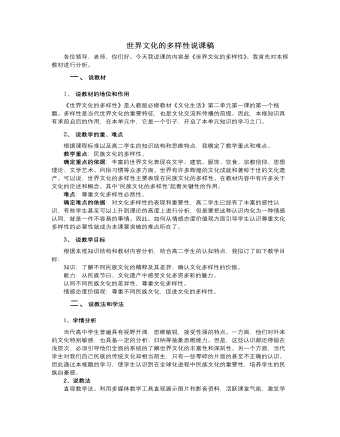
人教版高中政治必修3世界文化的多样性说课稿
1、 说教材的地位和作用《世界文化的多样性》是人教版必修教材《文化生活》第二单元第一课的第一个框题。多样性是当代世界文化的重要特征,也是文化交流和传播的前提。因此,本框知识具有承前启后的作用,在本单元中,它是一个引子,开启了本单元知识的学习之门。2、 说教学的重、难点根据课程标准以及高二学生的知识结构和思维特点,我确定了教学重点和难点。教学重点:民族文化的多样性。确定重点的依据:丰富的世界文化表现在文字、建筑、服饰、饮食、宗教信仰、思想理论、文学艺术、风俗习惯等众多方面。世界有许多辉煌的文化成就和著称于世的文化遗产。可以说,世界文化的多样性主要表现在民族文化的多样性。在教材内容中有许多关于文化的论述和概念。其中“民族文化的多样性”起着关键性的作用。难点:尊重文化多样性必然性。
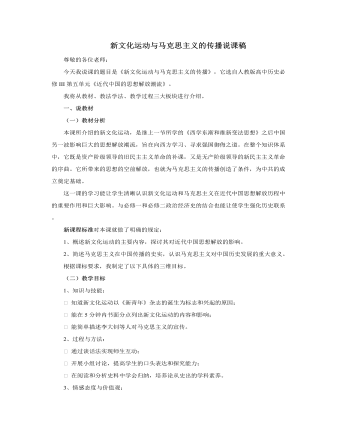
人教版高中历史必修3新文化运动与马克思主义的传播说课稿
一、说教材(一)教材分析本课所介绍的新文化运动,是继上一节所学的《西学东渐和维新变法思想》之后中国另一波影响巨大的思想解放潮流,旨在向西方学习、寻求强国御侮之道。在整个知识体系中,它既是资产阶级领导的旧民主主义革命的补课,又是无产阶级领导的新民主主义革命的序曲。它所带来的思想的空前解放,也就为马克思主义的传播创造了条件,为中共的成立奠定基础。这一课的学习能让学生清晰认识新文化运动和马克思主义在近代中国思想解放历程中的重要作用和巨大影响。与必修一和必修二政治经济史的结合也能让使学生强化历史联系。新课程标准对本课就做了明确的规定:1、概述新文化运动的主要内容,探讨其对近代中国思想解放的影响。2、简述马克思主义在中国传播的史实,认识马克思主义对中国历史发展的重大意义。根据课标要求,我制定了以下具体的三维目标。

高中历史人教版必修一《马克思主义的诞生》说课稿
一、教学理念在新课改精神指导下,我在本课教学中力求贯彻以下教学理念:新课标的指引观 、生本位的学生观、探究式的学习观、多角色的教师观、 发展性的评价观二、教材地位《马克思主义的诞生》是人教版必修一第五单元第18课内容,本课讲述的是国际共产主义运动范畴的历史,是人类社会进入一个新的发展时期。从总体上概述了社会主义从空想到科学,从理论到实践的历程。说明了科学社会主义理论是历史发展的必然结果。本课在国际工运史上占有重要的地位。通过学习学生可对马克思主义加深了解,理解人类历史发展的必然趋势以及人类一直不断追求进步的精神,帮助学生树立正确的人生观、价值观,达到以史鉴今,服务现实的目的。
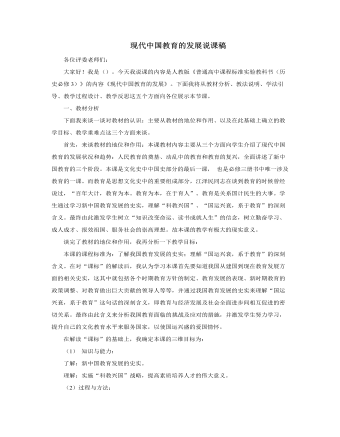
人教版高中历史必修3现代中国教育的发展说课稿
一、教材分析下面我来谈一谈对教材的认识:主要从教材的地位和作用、以及在此基础上确立的教学目标、教学重难点这三个方面来谈。首先,来谈教材的地位和作用:本课教材内容主要从三个方面向学生介绍了现代中国教育的发展状况和趋势:人民教育的奠基、动乱中的教育和教育的复兴,全面讲述了新中国教育的三个阶段。本课是文化史中中国史部分的最后一课, 也是必修三册书中唯一涉及教育的一课。而教育是思想文化史中的重要组成部分,江泽民同志在谈到教育的时候曾经说过,“百年大计,教育为本。教育为本,在于育人”。教育是关系国计民生的大事。学生通过学习新中国教育发展的史实,理解“科教兴国”、“国运兴衰,系于教育”的深刻含义。最终由此激发学生树立“知识改变命运、读书成就人生”的信念,树立勤奋学习、成人成才、报效祖国、服务社会的崇高理想。故本课的教学有极大的现实意义。谈完了教材的地位和作用,我再分析一下教学目标:
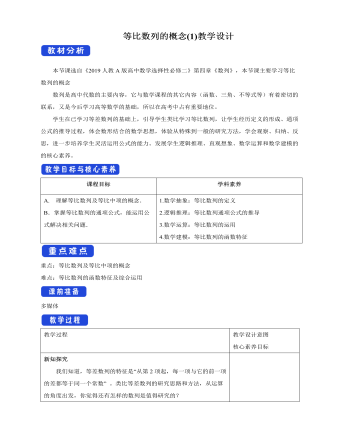
人教版高中数学选择性必修二等比数列的概念 (1) 教学设计
新知探究我们知道,等差数列的特征是“从第2项起,每一项与它的前一项的差都等于同一个常数” 。类比等差数列的研究思路和方法,从运算的角度出发,你觉得还有怎样的数列是值得研究的?1.两河流域发掘的古巴比伦时期的泥版上记录了下面的数列:9,9^2,9^3,…,9^10; ①100,100^2,100^3,…,100^10; ②5,5^2,5^3,…,5^10. ③2.《庄子·天下》中提到:“一尺之锤,日取其半,万世不竭.”如果把“一尺之锤”的长度看成单位“1”,那么从第1天开始,每天得到的“锤”的长度依次是1/2,1/4,1/8,1/16,1/32,… ④3.在营养和生存空间没有限制的情况下,某种细菌每20 min 就通过分裂繁殖一代,那么一个这种细菌从第1次分裂开始,各次分裂产生的后代个数依次是2,4,8,16,32,64,… ⑤4.某人存入银行a元,存期为5年,年利率为 r ,那么按照复利,他5年内每年末得到的本利和分别是a(1+r),a〖(1+r)〗^2,a〖(1+r)〗^3,a〖(1+r)〗^4,a〖(1+r)〗^5 ⑥

人教版高中数学选择性必修二等差数列的前n项和公式(1)教学设计
高斯(Gauss,1777-1855),德国数学家,近代数学的奠基者之一. 他在天文学、大地测量学、磁学、光学等领域都做出过杰出贡献. 问题1:为什么1+100=2+99=…=50+51呢?这是巧合吗?试从数列角度给出解释.高斯的算法:(1+100)+(2+99)+…+(50+51)= 101×50=5050高斯的算法实际上解决了求等差数列:1,2,3,…,n,"… " 前100项的和问题.等差数列中,下标和相等的两项和相等.设 an=n,则 a1=1,a2=2,a3=3,…如果数列{an} 是等差数列,p,q,s,t∈N*,且 p+q=s+t,则 ap+aq=as+at 可得:a_1+a_100=a_2+a_99=?=a_50+a_51问题2: 你能用上述方法计算1+2+3+… +101吗?问题3: 你能计算1+2+3+… +n吗?需要对项数的奇偶进行分类讨论.当n为偶数时, S_n=(1+n)+[(2+(n-1)]+?+[(n/2+(n/2-1)]=(1+n)+(1+n)…+(1+n)=n/2 (1+n) =(n(1+n))/2当n为奇数数时, n-1为偶数
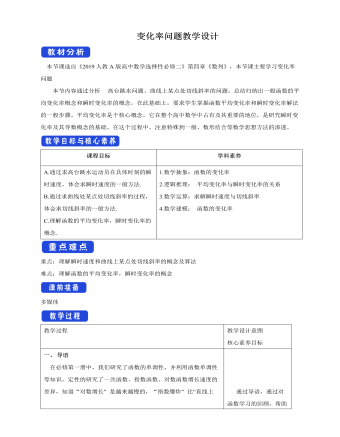
人教版高中数学选择性必修二变化率问题教学设计
导语在必修第一册中,我们研究了函数的单调性,并利用函数单调性等知识,定性的研究了一次函数、指数函数、对数函数增长速度的差异,知道“对数增长” 是越来越慢的,“指数爆炸” 比“直线上升” 快得多,进一步的能否精确定量的刻画变化速度的快慢呢,下面我们就来研究这个问题。新知探究问题1 高台跳水运动员的速度高台跳水运动中,运动员在运动过程中的重心相对于水面的高度h(单位:m)与起跳后的时间t(单位:s)存在函数关系h(t)=-4.9t2+4.8t+11.如何描述用运动员从起跳到入水的过程中运动的快慢程度呢?直觉告诉我们,运动员从起跳到入水的过程中,在上升阶段运动的越来越慢,在下降阶段运动的越来越快,我们可以把整个运动时间段分成许多小段,用运动员在每段时间内的平均速度v ?近似的描述它的运动状态。
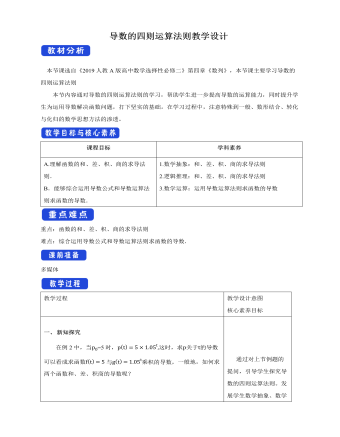
人教版高中数学选择性必修二导数的四则运算法则教学设计
求函数的导数的策略(1)先区分函数的运算特点,即函数的和、差、积、商,再根据导数的运算法则求导数;(2)对于三个以上函数的积、商的导数,依次转化为“两个”函数的积、商的导数计算.跟踪训练1 求下列函数的导数:(1)y=x2+log3x; (2)y=x3·ex; (3)y=cos xx.[解] (1)y′=(x2+log3x)′=(x2)′+(log3x)′=2x+1xln 3.(2)y′=(x3·ex)′=(x3)′·ex+x3·(ex)′=3x2·ex+x3·ex=ex(x3+3x2).(3)y′=cos xx′=?cos x?′·x-cos x·?x?′x2=-x·sin x-cos xx2=-xsin x+cos xx2.跟踪训练2 求下列函数的导数(1)y=tan x; (2)y=2sin x2cos x2解析:(1)y=tan x=sin xcos x,故y′=?sin x?′cos x-?cos x?′sin x?cos x?2=cos2x+sin2xcos2x=1cos2x.(2)y=2sin x2cos x2=sin x,故y′=cos x.例5 日常生活中的饮用水通常是经过净化的,随着水的纯净度的提高,所需进化费用不断增加,已知将1t水进化到纯净度为x%所需费用(单位:元),为c(x)=5284/(100-x) (80<x<100)求进化到下列纯净度时,所需进化费用的瞬时变化率:(1) 90% ;(2) 98%解:净化费用的瞬时变化率就是净化费用函数的导数;c^' (x)=〖(5284/(100-x))〗^'=(5284^’×(100-x)-"5284 " 〖(100-x)〗^’)/〖(100-x)〗^2 =(0×(100-x)-"5284 " ×(-1))/〖(100-x)〗^2 ="5284 " /〖(100-x)〗^2
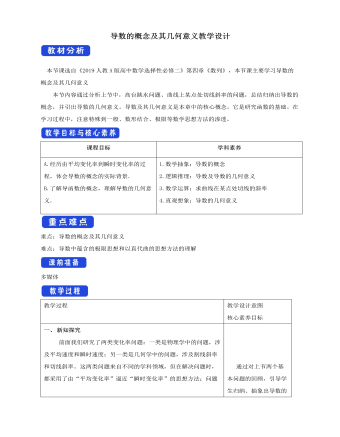
人教版高中数学选择性必修二导数的概念及其几何意义教学设计
新知探究前面我们研究了两类变化率问题:一类是物理学中的问题,涉及平均速度和瞬时速度;另一类是几何学中的问题,涉及割线斜率和切线斜率。这两类问题来自不同的学科领域,但在解决问题时,都采用了由“平均变化率”逼近“瞬时变化率”的思想方法;问题的答案也是一样的表示形式。下面我们用上述思想方法研究更一般的问题。探究1: 对于函数y=f(x) ,设自变量x从x_0变化到x_0+ ?x ,相应地,函数值y就从f(x_0)变化到f(〖x+x〗_0) 。这时, x的变化量为?x,y的变化量为?y=f(x_0+?x)-f(x_0)我们把比值?y/?x,即?y/?x=(f(x_0+?x)-f(x_0)" " )/?x叫做函数从x_0到x_0+?x的平均变化率。1.导数的概念如果当Δx→0时,平均变化率ΔyΔx无限趋近于一个确定的值,即ΔyΔx有极限,则称y=f (x)在x=x0处____,并把这个________叫做y=f (x)在x=x0处的导数(也称为__________),记作f ′(x0)或________,即
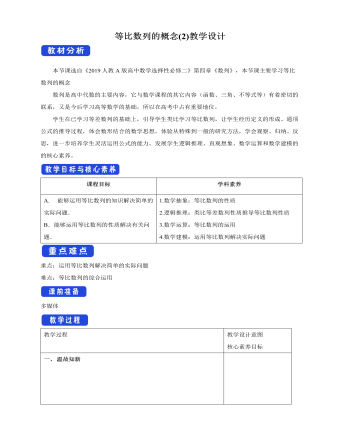
人教版高中数学选择性必修二等比数列的概念 (2) 教学设计
二、典例解析例4. 用 10 000元购买某个理财产品一年.(1)若以月利率0.400%的复利计息,12个月能获得多少利息(精确到1元)?(2)若以季度复利计息,存4个季度,则当每季度利率为多少时,按季结算的利息不少于按月结算的利息(精确到10^(-5))?分析:复利是指把前一期的利息与本金之和算作本金,再计算下一期的利息.所以若原始本金为a元,每期的利率为r ,则从第一期开始,各期的本利和a , a(1+r),a(1+r)^2…构成等比数列.解:(1)设这笔钱存 n 个月以后的本利和组成一个数列{a_n },则{a_n }是等比数列,首项a_1=10^4 (1+0.400%),公比 q=1+0.400%,所以a_12=a_1 q^11 〖=10〗^4 (1+0.400%)^12≈10 490.7.所以,12个月后的利息为10 490.7-10^4≈491(元).解:(2)设季度利率为 r ,这笔钱存 n 个季度以后的本利和组成一个数列{b_n },则{b_n }也是一个等比数列,首项 b_1=10^4 (1+r),公比为1+r,于是 b_4=10^4 (1+r)^4.
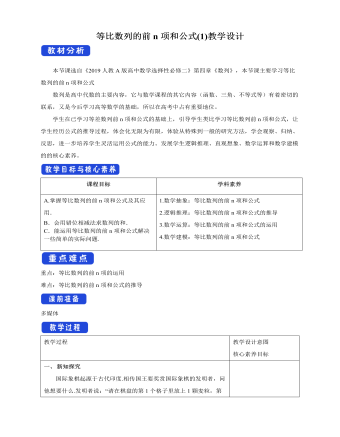
人教版高中数学选择性必修二等比数列的前n项和公式 (1) 教学设计
新知探究国际象棋起源于古代印度.相传国王要奖赏国际象棋的发明者,问他想要什么.发明者说:“请在棋盘的第1个格子里放上1颗麦粒,第2个格子里放上2颗麦粒,第3个格子里放上4颗麦粒,依次类推,每个格子里放的麦粒都是前一个格子里放的麦粒数的2倍,直到第64个格子.请给我足够的麦粒以实现上述要求.”国王觉得这个要求不高,就欣然同意了.假定千粒麦粒的质量为40克,据查,2016--2017年度世界年度小麦产量约为7.5亿吨,根据以上数据,判断国王是否能实现他的诺言.问题1:每个格子里放的麦粒数可以构成一个数列,请判断分析这个数列是否是等比数列?并写出这个等比数列的通项公式.是等比数列,首项是1,公比是2,共64项. 通项公式为〖a_n=2〗^(n-1)问题2:请将发明者的要求表述成数学问题.
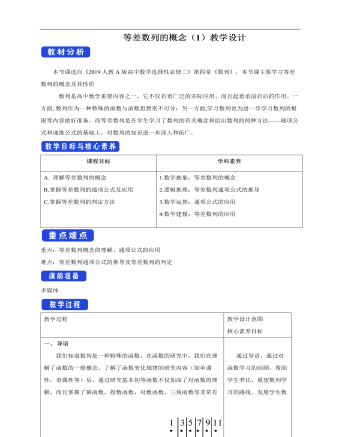
人教版高中数学选择性必修二等差数列的概念(1)教学设计
我们知道数列是一种特殊的函数,在函数的研究中,我们在理解了函数的一般概念,了解了函数变化规律的研究内容(如单调性,奇偶性等)后,通过研究基本初等函数不仅加深了对函数的理解,而且掌握了幂函数,指数函数,对数函数,三角函数等非常有用的函数模型。类似地,在了解了数列的一般概念后,我们要研究一些具有特殊变化规律的数列,建立它们的通项公式和前n项和公式,并应用它们解决实际问题和数学问题,从中感受数学模型的现实意义与应用,下面,我们从一类取值规律比较简单的数列入手。新知探究1.北京天坛圜丘坛,的地面有十板布置,最中间是圆形的天心石,围绕天心石的是9圈扇环形的石板,从内到外各圈的示板数依次为9,18,27,36,45,54,63,72,81 ①2.S,M,L,XL,XXL,XXXL型号的女装上对应的尺码分别是38,40,42,44,46,48 ②3.测量某地垂直地面方向上海拔500米以下的大气温度,得到从距离地面20米起每升高100米处的大气温度(单位℃)依次为25,24,23,22,21 ③





















